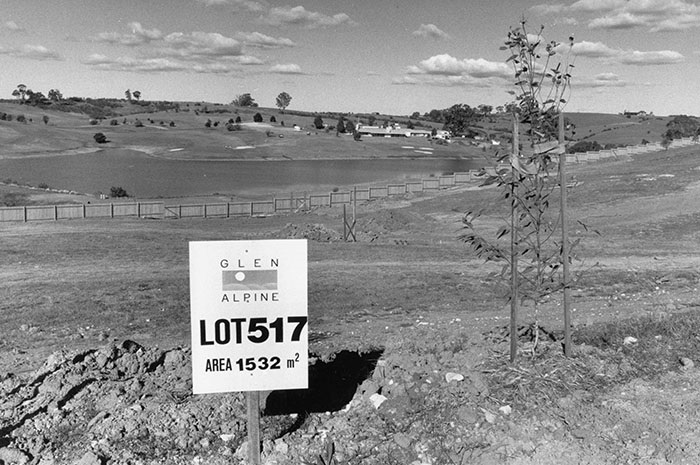History of Glen Alpine
The following text is from "Campbelltown's Streets and Suburbs - How and why they got their names" written by Jeff McGill, Verlie Fowler and Keith Richardson, 1995, published by Campbelltown and Airds Historical Society. Reproduced with kind permission of the authors.
"Glen Alpine" is the answer to your dreams!" Or so claimed the Lend Lease Corporation, in a 1986 promotion for its newest prestige housing estate.
A decade later, that same estate virtually surrounds the Campbelltown Golf Course. And aimed squarely at the well-heeled "executive" market, Glen Alpine boasts beautiful parks and large blocks of land, most of which are able to take a home, pool, outdoor entertainment area, or even a tennis court.

Glen Alpine lot for sale in 1987. Photo David Porter, Fairfax Collection.
Most people are aware the suburb name itself comes from Glen Alpine, the historic homestead which stands - fully restored - off Belltrees Close.
But a lot of people don't realise that it is not the original Glen Alpine, which was built by the Reddall family in the late 1820s.
Reverend Thomas Reddall was the first Anglican clergyman ever appointed to Campbelltown. He personally supervised the construction of St Peter's Church(PDF, 379KB) in Cordeaux Street, and served as its rector from 1823 until his death 15 years later.
The original Glen Alpine was built sometime in the late 1820s on land owned by his son, John Reddall, but was officially conveyed to Reddall senior's ownership.
The robust clergyman was well-known for his educational efforts in the Sydney schools, Aboriginal institutions, an exclusive boarding school for boys at Macquarie Fields, and a school at St Peters Church. (Thomas Reddall High School in Ambarvale recognises his work).
But Reddall died at his home in 1838, leaving his family to fight through a tangled web of financial problems. By the end of the century, the family had lost control of the property.
It's believed Glen Alpine fell into disrepair, and was eventually burnt to the ground in the early 1900s.
The site of that first home is now set aside as Heritage Park, off Abington Crescent, and still includes many of the original trees planted by the Reddall family.
The house which is now called Glen Alpine was built by James Sheil before World War One. The Sheils had taken over the property around 1900, and held it until the 1950s, when there was a string of other owners, including the former Mayor, Gordon Fetterplace.
By the early 1970s, the grassy hills were already earmarked for future development, and in 1976 the "Glen Alpine" suburb name was approved.
But shunted to the sidelines, the area was then left virtually ignored for years as housing estates spread across Ambarvale and Rosemeadow. The fact the NSW Water Board was unable to sewer the area for almost a decade, added to the delays. Apart from farming, the only major activity until the 1980s was sport. Campbelltown's new championship golf course had been created to replace the old course (behind the Catholic Club) which was closed to make way for the proposed "Regional Centre". In July 1978, NSW Governor, Sir Roden Cutler, officially opened the $2.5 million course and clubhouse.
When Lend Lease finally launched Glen Alpine housing estate in September 1986, it did so with the richest golfing tournament ever seen in the district.
From the start, Lend Lease had planned to develop its estate as a "prestige" one, surrounded by well-kept fairways and greens.
Year after year, high-income earners were enticed to buy. "Glen Alpine - because your address says a lot about who you are," proclaimed advertisements from 1991. "Quiet, gently curving streets and private cul-de-sacs, magnificent homes (and) superb gardens. This is a place where quality is expected, success is taken for granted, and perfection is a way of life."
In 1986, Council approved Lend Lease's suggestion that main roads in the suburb be named after surrounding landmarks. Glen Alpine Drive notes, of course, the old house, while Heritage Way takes its name from the park which marks the site of the original home.
Mount Huon Circuit recalls a dairy farm which had stood next to Glen Alpine property earlier this century, just south of modern Macarthur Square. Mount Sugarloaf was a large farm to the south.
At the same time, minor roads were designed to pay tribute to some of Australia's premier homesteads. Some of these include Figtree House, Belltrees, Armytage House, Ashfield Castle, Clydebank House, Werribee Park, Narryna, Loder House, Somercoates, Fernhill and Charnwood Court.
Some of the less ear-pleasing homestead titles - Euro-Reko, Bontharambo and Grossman House - remain unused.
It should be noted that the old Reddall grant actually only covered the southern portion of the modern suburb. Land now occupied by streets north of the main Glen Alpine Drive roundabout was once a patchwork of small farming grants held by John Kellicar, Daniel Geary and Daniel Tindall.
If these names seem familiar, don't be too surprised. Kellicar Road, Geary Street and Tindall Street can all be found near Macarthur Square today.
By 1991, just five years after Glen Alpine was launched, 620 blocks had already been sold and 260 executive homes built.
Housing developments are now spreading to the eastern side of the golf course dam, toward Ambarvale. And when the suburb is complete, Lend Lease predicts it will have more than 1200 homes.